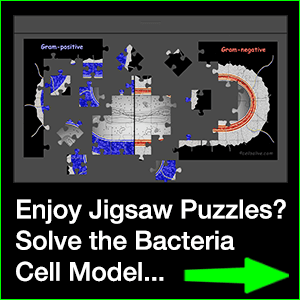Bacteria (Prokaryotes) are simple in structure, with no recognizable organelles. They have an outer cell wall that gives them shape. Just under the rigid cell wall is the more fluid cell membrane. The cytoplasm enclosed within the cell membrane does not exhibit much structure when viewed by electron microscopy. Use the following animation to explore bacterial structure.
 Connections
Connections
- Watch bacteria Swim and Tumble
- Get the Bacteria Cell PowerPoint
- Download a Bacteria Cell Worksheet
- Take the Microbe Quiz
Nucleoid: DNA in the bacterial cell is generally confined to this central region. Though it isn't bounded by a membrane, it is visibly distinct (by transmission microscopy) from the rest of the cell interior.
Genophore: The genophore, sometimes referred to as the bacterial chromosome, is a long double strand of DNA, usually in one large circle. It includes most of the genetic material of the organism (see Plasmid).
Plasmid: Plasmids are small circular DNA fragments found in the cytoplasm that contain code responsible for antibiotic resistance and other characteristics. Plasmids and the associated traits can be transferred between bacteria, even from one bacterial species to another.
Cytoplasm: This internal "soup" of the bacterial cell is bounded on the outside by the cell envelope. The cytoplasm is mostly water, but within it are the bacterial inclusions - nucleoid, plasmids, ribosomes and storage granules - as well as the components necessary for bacterial metabolism.
Endospore: Some bacteria can survive hostile environments, often for long time periods, by bundling their genetic material in a tough internal structure. Endospores can withstand heat, cold, radiation, and lack of nutrition.
Ribosomes: Ribosomes give the cytoplasm of bacteria a granular appearance in electron micrographs. Though smaller than the ribosomes in eukaryotic cells, these inclusions have a similar function in translating the genetic message in messenger RNA into the production of peptide sequences (proteins).
Storage Granules: Nutrients and reserves may be stored in the cytoplasm in the form of glycogen, lipids, polyphosphate, or in some cases, sulfur or nitrogen.
Cell Envelope
Beginning from the innermost structure and moving outward, bacteria have some or all of the following structures:
Plasma Membrane: This is a lipid bilayer much like the cytoplasmic (plasma) membrane of other cells. There are numerous proteins moving within or upon this layer that are primarily responsible for transport of ions, nutrients and waste across the membrane.
Periplasmic Space: This cellular compartment is found only in those bacteria that have both an outer membrane and plasma membrane (e.g. Gram negative bacteria). In the space are enzymes and other proteins that help digest and move nutrients into the cell.
Cell Wall: Composed of peptidoglycan (polysaccharides + protein), the cell wall maintains the overall shape of a bacterial cell. The three primary shapes in bacteria are coccus (spherical), bacillus (rod-shaped) and spirillum (spiral). Mycoplasma are bacteria that have no cell wall and therefore have no definite shape.
Outer Membrane: This lipid bilayer is found in Gram negative bacteria and is the location of lipopolysaccharide (LPS) in these bacteria. Gram positive bacteria lack this layer. LPS can be toxic to a host and can stimulate the host's immune system.
Capsule: This layer of polysaccharide (sometimes proteins) protects the bacterial cell and is often associated with pathogenic bacteria because it serves as a barrier against phagocytosis by white blood cells. Capsules can be seen by viewing bacteria in India ink.
Appendages
Bacteria may have the following appendages.
Pili, Fimbriae: These hollow, hairlike structures made of protein allow bacteria to attach to other cells. A specialized pilus, the sex pilus, allows the transfer of plasmid DNA from one bacterial cell to another. Pili (sing., pilus) are also called fimbriae (sing., fimbria).
Flagella: The purpose of flagella (sing., flagellum) is motility. Flagella are long appendages which rotate by means of a "motor" in the cell envelope. Bacteria may have one, a few, or many flagella in different positions on the cell.


